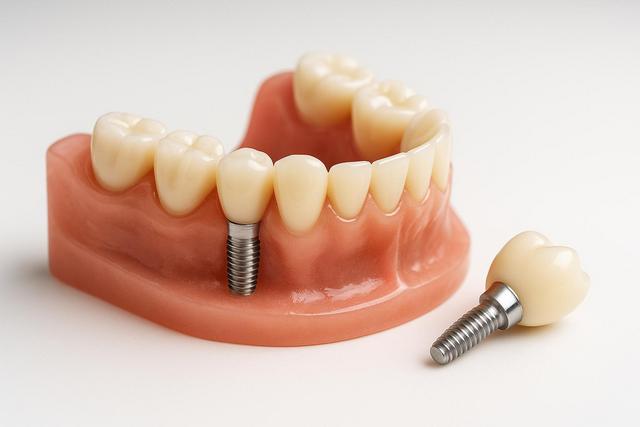
Dental Implants: Benefits, Longevity, and Everyday Care
What Dental Implants Are—and Why They’re Among the Top Options
A dental implant is a small post that replaces a missing tooth root. After placement in the jawbone and a period of healing, a connector (abutment) and a custom crown, bridge, or denture are attached to restore chewing and aesthetics. Because implants are anchored in bone, they feel stable and can help preserve jawbone volume—an advantage over options that rest on the gums. For many adults who have lost one tooth or several, implants are a well‑regarded solution that avoids filing down healthy neighboring teeth for a traditional bridge.
Implants are versatile. They can support a single crown, an implant‑supported bridge replacing multiple teeth, or a full‑arch prosthesis anchored by several implants. Your dentist or specialist will evaluate bone quantity, gum health, medical history, and bite forces to personalize the plan. The process can be staged over several months or, in carefully selected cases, completed sooner with immediate or early loading protocols. We cover both approaches below, along with care tips and longevity facts.
Benefits You Can Feel in Daily Life
- Tooth‑by‑tooth restoration. Implants replace only what’s missing, leaving adjacent teeth untouched—an approach many clinicians consider conservative compared to a tooth‑supported bridge [1].
- Stable chewing and clear speech. Because the implant fuses with bone, most people report a secure, natural feel, whether biting into an apple or speaking confidently [2].
- Long‑term performance documented in research. Contemporary implants show high survival at 10 years in the literature—around the mid‑90% range at the implant level—when planned and maintained appropriately [3].
- Bone preservation. Like a natural root, an implant transmits functional load into the jaw. That stimulation can help reduce the bone resorption commonly seen after tooth loss [1].
Expert quote: “Think of an implant as a precision joint—you’ll get the most out of it with routine care, mindful habits, and periodic check‑ups.”
Longevity: What the Evidence Shows—and What Affects It
When people ask, “How long do dental implants last?”, the honest answer is that they can function for decades, but outcomes vary by health, habits, prosthesis design, bite forces, and maintenance. A sensitivity meta‑analysis of contemporary systems reported an estimated 10‑year survival near 96% (traditional analysis) at the implant level, with variability across studies and patient factors [3].
Equally important is the health of the tissues around the implant. Reviews using standardized diagnostic criteria report that peri‑implant diseases are not rare; peri‑implantitis may affect roughly one in five patients over time, with risk linked to modifiable and systemic factors such as smoking, a history of periodontitis, and diabetes [4] [5]. The takeaway: effective home care and regular professional maintenance are not optional extras—they are part of the therapy.
- Lifestyle factors: Tobacco use and uncontrolled diabetes are associated with higher complication rates around implants [4].
- Gum history: Prior or current periodontitis elevates risk, underscoring the value of periodontal stabilization before implant therapy [4].
- Prosthesis design: Cleanability matters. Implant‑supported restorations that are easier to access often support better long‑term hygiene and tissue health [11].
The Treatment Journey: From Evaluation to Smiling Again
Implant care begins with a comprehensive exam, imaging (such as 3D cone‑beam scans), and a review of your health status. Some patients require preparatory procedures like bone grafting or sinus augmentation before placement. After surgery, the implant typically integrates with bone over several weeks to months (conventional loading). In selected cases with excellent primary stability and favorable bite conditions, the crown or bridge can be attached sooner (immediate or early loading). Evidence suggests that while immediate loading can perform comparably in well‑selected scenarios, it may carry a slightly higher risk of implant loss compared with conventional loading; your clinician will explain whether you’re a candidate [8].
- Single‑tooth replacement: One implant and one crown.
- Multiple adjacent teeth: Two implants can support a bridge, reducing the number of posts needed.
- Full‑arch solutions: A fixed bridge can be supported by several implants, restoring smile and function across an entire arch [11].
Everyday Care: A Simple Routine That Protects Your Investment
Home care around implants looks familiar—twice‑daily brushing and once‑daily interdental cleaning—with a few nuances. Evidence indicates that interdental brushes may reduce gingival inflammation more than floss in the short term for many users; water flossers (oral irrigators) can also be helpful. The quality of evidence varies, but the practical message is to pick effective tools you’ll use consistently [6] [7].
- Brush: Use a soft manual or powered brush. Angle bristles toward the gumline to clean the base of the implant crown [2].
- Clean between: Choose interdental brushes sized to your spaces, specialty floss/threaders for bridges, or a water flosser—your dental team can tailor a plan [6] [7].
- Rinse smartly: Alcohol‑free mouthrinses are gentler on soft tissues. Ask about options that fit your needs [7].
- See your dentist regularly: Professional monitoring and cleanings catch early changes before they become problems [2].
Risks, Complications, and How to Reduce Them
Implants are widely performed and considered reliable; still, no surgery is risk‑free. Reported complications include infection, soft‑tissue inflammation, peri‑implant disease, nerve irritation, sinus involvement (upper jaw), and mechanical wear or loosening of screws and prosthetic parts. Avoid chewing ice and hard candy, wear a night guard if you grind your teeth, and follow post‑op instructions closely—these small habits meaningfully lower risk [2] [4].
Costs, Insurance, and Practical Budgeting
Total cost depends on the number of implants, the restoration type, region, and whether preparatory procedures are needed. Published consumer health estimates, drawing on dental fee surveys, place a single‑tooth implant (implant + abutment + crown) roughly in the $3,100–$5,800 range, with multi‑tooth bridges and full‑arch options costing more due to additional parts and visits [10].
- Dental insurance: Many plans cover portions of the surgical or restorative steps, often with annual maximums and waiting periods. Pre‑authorization helps you see the breakdown before you commit.
- Medicare: Traditional Medicare does not routinely cover dental implants; limited exceptions apply when a dental service is inextricably linked to a covered medical service. Policy and claims rules are evolving—your clinicians can advise how current CMS guidance may apply in your case [9].
- Payment options: Health savings accounts and financing programs are commonly used to spread costs over time. Compare fees and timelines across providers.
Materials and Design Choices: Titanium, Titanium‑Zirconium, and Zirconia
The vast majority of implants are titanium or titanium‑alloy because of their strength and long track record. Zirconia (ceramic) implants appeal to some patients for metal‑free preferences. Current comparative analyses generally show high survival for titanium and titanium‑zirconium, with zirconia showing promising yet more limited long‑term data and somewhat lower survival in several reviews. Your choice should consider bite forces, location, esthetics, and maintenance access [12] [13].
Implants vs. Bridges vs. Dentures: A Quick Comparison
| Aspect | Dental Implant | Tooth‑Supported Bridge | Removable Denture |
|---|---|---|---|
| Longevity (with care) | Documented long‑term survival; can last decades | Often 7–10+ years before replacement of parts | Relines/replacements more frequent |
| Bone preservation | Helps preserve jawbone via functional load [1] | No direct bone stimulation | No direct bone stimulation |
| Impact on adjacent teeth | None (tooth‑by‑tooth) | Requires shaping neighbor teeth | None |
| Chewing comfort | Stable, natural feel [2] | Good | Variable; may move, need adhesives |
| Daily cleaning | Brush + interdental cleaning tailored to design [6] | Floss threaders/interdental aids under pontics | Remove to clean; clean gums/tongue |
| Typical visits | Surgery + restorative phases, then routine maintenance | Fewer initial visits; periodic checks | Adjustments/relines more common |
Life With Implants: Eating, Exercise, Travel
- Eating: After healing, most foods are fine. Still, be cautious with very hard items that can chip any crown (implant or natural) [2].
- Exercise: Resume gradually after surgery as advised. Mouthguards are wise for contact sports.
- Travel: Pack your interdental tools; schedule maintenance ahead of long trips. Airport scanners don’t typically pose issues for dental implants.
FAQs
Frequently Asked Questions
How long will my implant take from start to finish?
Simple cases may be completed in several months with conventional loading; carefully selected cases might use immediate or early loading, but candidacy depends on bone quality, bite, and stability at placement [8].
Do implants ever fail?
Yes—though uncommon with good planning and care. Risk increases with smoking, uncontrolled diabetes, and a history of gum disease. Early detection and maintenance reduce complications [4] [5].
What’s the most important home‑care step?
Whichever interdental method you’ll use daily. Interdental brushes and water flossers can be effective options; your hygienist can size and demonstrate the tools that fit your restoration [6] [7].
Are ceramic (zirconia) implants right for me?
They can be considered for metal‑free preferences, especially in the esthetic zone. Current comparative reviews generally favor titanium/titanium‑zirconium for survival; discuss site, bite forces, and esthetics with your provider [12] [13].
Will Medicare cover my implant?
Typically no, unless the dental service is inextricably linked to a covered medical service under current CMS rules. Check specifics with your clinicians and insurer before treatment [9].
Websources
- [1] American Dental Association – MouthHealthy: Implants
- [2] Mayo Clinic – Dental implant surgery: Preparation and care
- [3] Systematic review: 10‑year implant survival (2019)
- [4] AO/AAP systematic review: Peri‑implant disease risk factors (2025)
- [5] BMC Oral Health (2022): Peri‑implantitis prevalence estimates
- [6] Cochrane Review: Home interdental cleaning devices
- [7] ADA: Floss and interdental cleaners
- [8] Meta‑analysis: Immediate vs. conventional loading
- [9] CMS: Medicare dental coverage (policy details)
- [10] Forbes Health: Dental implant cost overview
- [11] American Academy of Periodontology: Implant procedures
- [12] Meta‑analysis: Titanium vs. zirconia vs. Ti‑Zr outcomes
- [13] Systematic review of RCTs: Zirconia vs. titanium (1‑year outcomes)


